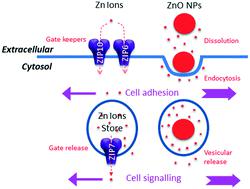当前位置:
X-MOL 学术
›
Environ. Sci.: Nano
›
论文详情
Our official English website, www.x-mol.net, welcomes your
feedback! (Note: you will need to create a separate account there.)
Toxicogenomics in a soil sentinel exposure to Zn nanoparticles and ions reveals the comparative role of toxicokinetic and toxicodynamic mechanisms
Environmental Science: Nano ( IF 5.8 ) Pub Date : 2020-03-23 , DOI: 10.1039/c9en01124b Marta Novo 1, 2, 3, 4, 5 , Elma Lahive 5, 6, 7, 8 , María Díez Ortiz 5, 6, 7, 8, 9 , David J. Spurgeon 5, 6, 7, 8 , Peter Kille 1, 2, 3, 4, 5
Environmental Science: Nano ( IF 5.8 ) Pub Date : 2020-03-23 , DOI: 10.1039/c9en01124b Marta Novo 1, 2, 3, 4, 5 , Elma Lahive 5, 6, 7, 8 , María Díez Ortiz 5, 6, 7, 8, 9 , David J. Spurgeon 5, 6, 7, 8 , Peter Kille 1, 2, 3, 4, 5
Affiliation

|
A critical question for read across of the hazards of nanomaterials is the degree to which their mechanisms of action differ from those of their bulk chemical constituents. It has been established that metal and metal oxide nanoparticles (NPs) can be accumulated by invertebrate species. Moreover, it has been hypothesised that the observed toxicity resulting on exposure to these nanomaterials is most likely to be associated with the releases of ions from external or internal dissolution leading ultimately to toxicity. However, mechanistic confirmation of the similar modes of action for metal oxide nanomaterials and metal ions in studies invertebrates are largely lacking. Therefore, here we present a toxicogenomic study using exposed individuals of the earthworm Eisenia fetida from a single genetic lineage. We compared gene expression and pathway responses through RNA-seq analysis at equitoxic concentrations (EC50 for reproduction) of ZnO NPs and ionic Zn. We found similar transcriptomic effects for both Zn forms with genetic signatures of tight control of cytosolic Zn concentrations through expression changes of genes encoding several Zn transporters. Activation and regulation of JUN, MAP and JNK kinases indicated a cellular response to the increased Zn concentrations of both forms with compound binding terms also enriched. Our results illustrate the need to consider both toxicokinetic and toxicodynamic mechanisms in the development of adverse outcome pathways for nanomaterials.
中文翻译:

土壤前哨暴露于锌纳米颗粒和离子中的毒物基因组学揭示了毒物动力学和毒物动力学机制的比较作用
读懂纳米材料危害的一个关键问题是它们的作用机理与其整体化学成分的不同程度。已经确定,无脊椎动物物种可以积累金属和金属氧化物纳米颗粒(NPs)。此外,已经假设,由于暴露于这些纳米材料而导致的观察到的毒性最有可能与从外部或内部溶解释放的离子有关,最终导致毒性。然而,在研究无脊椎动物中,金属氧化物纳米材料和金属离子的相似作用方式的机理研究尚缺乏。因此,在这里,我们使用usingEisenia fetida的裸露个体进行毒理基因组研究来自单一的遗传谱系。我们比较了在等毒浓度(EC 50用于繁殖)的ZnO NPs和离子型Zn时,通过RNA-seq分析进行的基因表达和途径反应。我们发现,通过编码几种锌转运蛋白的基因的表达变化来严格控制细胞内锌浓度,具有两种锌形式的类似转录组效应。JUN,MAP和JNK激酶的激活和调节表明细胞对这两种形式的Zn浓度增加的反应,化合物结合术语也丰富了。我们的结果表明,在开发纳米材料不良结局途径时,需要同时考虑毒物动力学和毒物动力学机制。
更新日期:2020-03-23
中文翻译:

土壤前哨暴露于锌纳米颗粒和离子中的毒物基因组学揭示了毒物动力学和毒物动力学机制的比较作用
读懂纳米材料危害的一个关键问题是它们的作用机理与其整体化学成分的不同程度。已经确定,无脊椎动物物种可以积累金属和金属氧化物纳米颗粒(NPs)。此外,已经假设,由于暴露于这些纳米材料而导致的观察到的毒性最有可能与从外部或内部溶解释放的离子有关,最终导致毒性。然而,在研究无脊椎动物中,金属氧化物纳米材料和金属离子的相似作用方式的机理研究尚缺乏。因此,在这里,我们使用usingEisenia fetida的裸露个体进行毒理基因组研究来自单一的遗传谱系。我们比较了在等毒浓度(EC 50用于繁殖)的ZnO NPs和离子型Zn时,通过RNA-seq分析进行的基因表达和途径反应。我们发现,通过编码几种锌转运蛋白的基因的表达变化来严格控制细胞内锌浓度,具有两种锌形式的类似转录组效应。JUN,MAP和JNK激酶的激活和调节表明细胞对这两种形式的Zn浓度增加的反应,化合物结合术语也丰富了。我们的结果表明,在开发纳米材料不良结局途径时,需要同时考虑毒物动力学和毒物动力学机制。











































 京公网安备 11010802027423号
京公网安备 11010802027423号